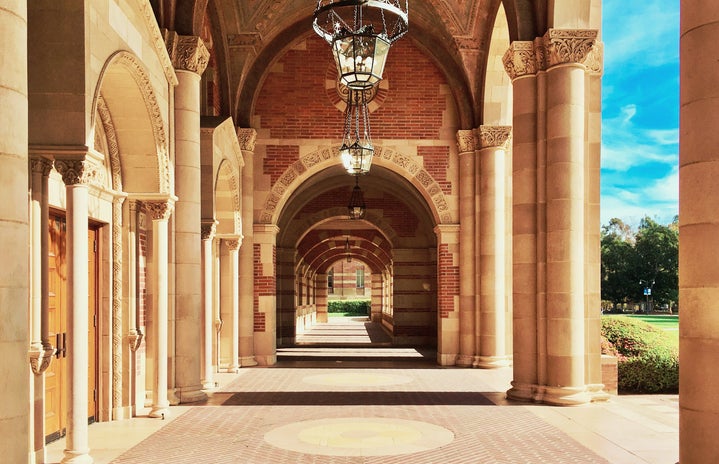As we head into the second week of Black History Month with spring course enrollment on the horizon, it’s as important as ever to examine the diversity of UCLA’s course offerings. However, scrolling through our course catalog reveals little about the depth of inclusion within our curriculum, so I reached out to over a dozen professors across just as many disciplines to learn which GEs are incorporating Black perspectives into their curriculum. This is a short list of the replies I received, as well as a call to action for UCLA to ensure that our campus and our curriculum reflects the same diversity that has advanced academia throughout history.
- ENVIRON M30 – Environmental Literature and Culture
-
FOUNDATIONS OF ARTS AND HUMANITIES—LITERARY AND CULTURAL ANALYSIS
This cross-listed English and Environmental Science class dives deep into the various literary representations of environmental issues. Professor and chair of the UCLA Department of English Ursula Heise wrote in a statement to Her Campus at UCLA, “(Environ M30) emerged from the basic assumption in the Environmental Humanities that ecological crises are as much matters of historical memory, social structures, and cultural practices— including storytelling and image creation— as of science and technology.”
A class about environmental issues would be incomplete without recognizing the disproportionate impact of environmental hazards on Black communities. Heise’s class does this by teaching texts by foundational Black scholars and activists including the oft-labeled “Father of Environmental Justice” Robert Bullard. Bullard’s Dumping in Dixie: Race, Class, and Environmental Quality, which Heise calls “the ground-breaking text for environmental justice in the US,” chronicles how African American communities mobilized against the disproportionate siting of toxic waste dumps in poor communities of color. “Thinking about environmental justice and environmental racism has profoundly reshaped the environmental movement in the US since the 1990s,” Heise wrote.
Heise also teaches about the Green Belt Movement. Started by African eco-feminist Wangari Maathai, the movement has planted over 51 million trees in Kenya since 1977. “(Maathai’s) Nobel Prize acceptance speech is a staple for the class,” Heise wrote. “(The speech is) inspiring in how it shows how she connected her life-long struggles for the rights of African women with environmental restoration.”
Heise believes in the importance of celebrating Black climate activists in spaces that tend to amplify less diverse voices. “This activism has now been taken up by younger African activists like Elizabeth Wanjiru Wathuti, for whom tree planting is also part of climate justice, another important topic for the class,” she wrote. “The young Swedish activist Greta Thunberg has tended to get a lot of media coverage, but the work of young African climate justice fighters is just as important.”
Heise wants students leave the class with a deeper understanding of how media impacts our environmental consciousness. “I hope the class gives students with an interest in environmental issues a sense of how fundamental issues of culture, justice, and inequality are for developing paths forward,” she wrote.
- MUSCLG 13 – Punk: Music, History, Subculture
-
Foundations of Arts and Humanities—Visual and Performance Arts Analysis and Practice
Diversity — Letters and Science, Education and Information Studies, Music, Public Affairs
There is so much to learn about the punk subculture, from its fascinating history to its contemporary influences on fashion and art. The punk ethos originated from punk rock, a genre of music that arose in the 1970s in reaction to the mainstream pop music of the time. As a subgenre of rock n’ roll, punk rock has roots in the work of Black musicians who defined much of musical history. In her statement for Her Campus at UCLA, Associate Professor Jessica Schwartz wrote that her class begins with Black musical contributions to punk “from Vera Hall’s folk songs to Delta blues to Chicago blues to R&B (before and beyond) as well as Black punk, Afro-punk (movement), African punk, intersections of hip-hop and punk, appropriation/colonialism and also appreciation and community-building.” In addition to providing an unabridged historical overview of punk, the class spotlights early Black punk figures and bands including Pure Hell, Fishbone and Bad Brains, and influential figures Tequila Mockingbird and Gary Allen.
Musical history is rife with the unrecognized contributions of Black talent, and Schwartz makes sure to emphasize when and where these omissions take place. Her class connects historical context such as 1950s mass media culture and civil rights legislation to the increasing whitewashing of punk rock and the consequent diversion of funds from Black musicians and the Black community.
But Black musicians don’t only exist in punk rock history: Schwartz’s class works to recognize contemporary Black punk rock as well. Students will watch the documentary Afro-Punk, the 2003 documentary that later inspired the contemporary Afropunk movement and the Brooklyn Afropunk festival. In their week on zines, which are self-published fan magazines, the class recognizes Black punk zinesters such as the author of Shotgun Seamstress, Osa Atoe. Finally, Schwartz covers African punk scenes and a range of contemporary Black punk bands such as FUPU, Mykki Blanco and Big Joanie and their involvement in queer, BIPOC and diasporic punk communities.
The punk subculture is all about subverting societal norms, but Schwartz’s class also questions the norms of the subculture. “It’s important to share the historical means of oppression and segregation that historically allowed punk to become whitewashed,” she wrote. “And, yet, that isn’t the whole story because it’s important to amplify Black punks’ musical contributions, voices, and stories.”
- LBR STD 10 – Introduction to Labor and Workplace Studies
-
Foundations of Society and Culture—Historical Analysis
Foundations of Society and Culture—Social Analysis
Diversity — Letters and Science, Education and Information Studies, Music, Public Affairs
We can all benefit from learning about the history of labor and the Black activists who fought to abolish many exploitative labor practices. Professor Abel Valenzuela, who has previously taught this introductory course on labor studies, promotes it as an exploration of market inequities through the lens of social justice. “Students are exposed to a wide variety of racial differences and how they might be played out in contemporary and historical context, including intersections across immigration, gender, urbanism, and politics,” he wrote in a statement to Her Campus at UCLA. “It’s a great class!”
The director of the UCLA Labor Center, Kent Wong, will be teaching the class next quarter. “Our core course for UCLA Labor Studies is entitled, ‘Class, Race and Social Justice,’” he wrote to Her Campus at UCLA. “Black workers have been crucial in building the labor movement over many generations, and the intersection between the labor movement and the struggle for racial justice has been transformational within our society.”
Original photo by Elyse Foreman
Black scholars and activists have played pivotal roles in fields from environmental science to musicology. Whether you are sampling interesting classes outside of your major or simply fulfilling your GEs, it is valuable to consider what perspectives are represented within your curriculum.





